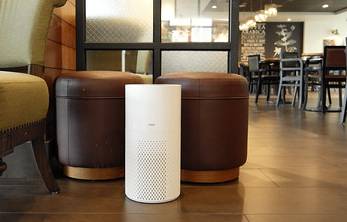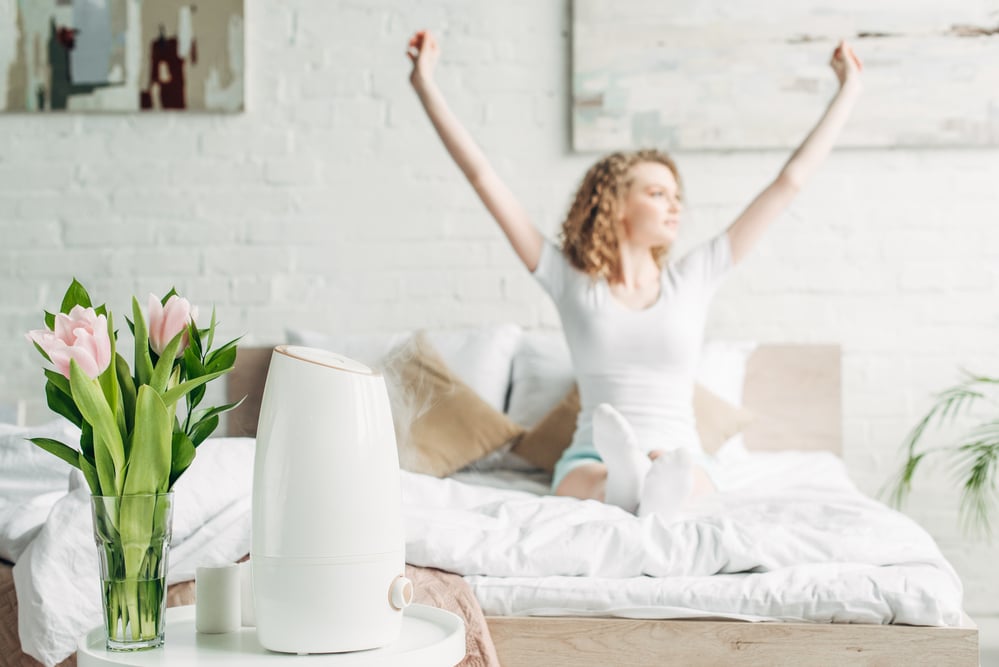Last Updated on February 23, 2023
So you’ve made the plunge and decided to improve your home air quality with an air purifier. Great choice. But do you know how to use an air purifier? Often, air purifier usage instructions are oversimplified or non-existent.
Here’s our guide on how to get the most out of your air purifier for cleaner, fresher air.
Using an Air Purifier
Struggling to work out how to set up your air purifier? You’re not alone! Many consumers are confused by the initial steps of configuring these gadgets. To help you get started, we’ve put together an easy guide on the best way to use your air purifier for the best results.
Step 1: Choose the Best Location

The very best location for your air purifier is right in the middle of your room. A central location allows your air purifier to filter the air across your room more evenly.
In practice, however, it’s pretty unlikely that you will want to place your air purifier smack bang in the middle of your living room or busy kitchen. Chances are you were thinking of placing it somewhere more discrete, say in a corner, on a side table or up against a wall. After all, even the best looking models aren’t really a design statement.
Bearing this in mind, if you don’t want to or can’t place your air purifier in the centre of your room, at least make sure that it has plenty of space around to take in and filter out air. If possible, occasionally moving it over to the other side of your room will help ensure that all of your room’s air is improved. Alternatively, you could use a discrete table fan to help to improve indoor air circulation.
Above all, ensure that your air purifier inlet and outlet ducts are not blocked or restricted by anything. Restricting the airflow will stop your air purifier from working effectively.
Step 2: Keep Windows and Doors Closed
Like with an air conditioner unit, you must keep your windows and door closed when using your air purifier. All air purifiers have their limits. If you put on your air conditioning unit and left the window open in summer, you wouldn’t be surprised to find that your room hardly cooled down. It’s just the same with an air purifier. You want to keep the contaminated outdoor air outside for effective air filtration.
If you have a large open plan area that needs purifying, you’ll have to ensure that your air purifier is up to the job with a large enough range and CADR (Clean Air Delivery Rate). If it’s not sufficient for the space, you’ll need to consider replacing it with a more powerful air purifier or buying a second model.
Step 3: Choose the Right Settings
There are multiple settings available for you to choose from while using an air purifier. HEPA air purifiers with auto-sensing settings will automatically adjust themselves to optimum levels. With high-speed settings, your air purifier will draw in more air, so more airborne particles and polluted air will be filtered and expelled as pure air.
You’ll have to experiment with your new air purifier depending on its speed and noise levels. However, it is safe to say that if you have a lot of pollutants or strong allergy symptoms, you’ll want to run it on high for at least several hours. This will ensure you get good air purification levels.
Slow fan speeds and sleep modes can be useful to keep your air quality up. But if you are faced with frequent door and window openings, then you’d be better off keeping your air cleaner running at a high fan setting.
Step 4: Replace Filters Regularly

Even if your model has a change air filters reminder, you’ll still need to watch the filter to ensure optimum results. Most good air purifiers have washable filters or pre-filters that can be vacuumed clean.
A pre-filter’s purpose is to trap large particles such as pet fur and dust. Doing so will greatly extend the life of your HEPA air filter (High-Efficiency Particulate Air filter) and prevent your machine from becoming clogged up.
Manufacturers of many air purifiers recommend fitting replacement filters (HEPA filters and activated carbon air purifier filters) around once every 6-12 months. However, this depends upon your usage and your home’s air pollution levels.
Ensure that you always have a spare filter to hand and check it at least once a week when you clean out your pre-filter for fully purified fresh air.
Air Purifiers FAQ
Check out these few frequently asked questions for other concerns regarding its use.
Are air purifiers expensive to run?
Understandably, no one wants to be presented with an extra high electricity bill after purchasing a new electronic appliance. Fortunately, most air purifiers have low wattage and do not cost very much to run, being highly energy efficient.
Small air purifiers tend to consume around 30 watts per hour, while larger models with higher CADRs can come at around 60 watts per hour. Obviously, running your home air purifier at full fan speed will consume more electricity than in night mode.
However, don’t be drawn into a false economy by restricting the number of hours you run your air purifier — if your indoor air pollution levels are good and stay down, then fine. On the other hand, if you get a lot of airborne allergens throughout the day, you may be better off leaving your air purifier on at higher speeds for longer durations.
Should I leave my air purifier on 24/7?
Unless you only rely upon your air purifier for seasonal hay fever relief, we recommend leaving your air purifier running all of the time. Why? Well, this is the best way to use an air purifier effectively. Doing so is the only way to benefit from your air purifier by ensuring that you and your family breathe in pure air. It can also help reduce mould growth, attract particles that may cause airway irritation and provide allergy relief long-term.
If you are worried about energy costs, you can always pick up a connected model (or one with an auto sensor) and schedule it to slow down when your indoor air quality levels are good. Air purifiers from well-known brands are rigorously tested. Plus, their motors have been manufactured to withstand years of long term use.
For ongoing problems like dust mites, mould growth, secondhand smoke, and VOCs (Volatile Organic Compounds), you will definitely want to keep your air purifier on 24/7 while you take other steps to resolve the root of these problems. Any known lung irritant substances will need to be physically removed from your home as soon as possible.
Enjoying Pure and Clean Air
You have learnt that using an air purifier is very easy, especially if you’ve gone for an auto-sensing model. The most important takeaways from our article on how to use an air purifier are location and matching your air purifier’s runtime duration and speed to your environment.
Bear these factors in mind, check on your filters regularly and enjoy fresh, pure air at home, with fewer allergy symptoms and colds.
Kelly is an expert in consumer product research, which is very important when it comes to finding the most useful and aesthetically pleasing items for your home. This became her passion after finding it very time-consuming to wade through all the product information online.
She has a keen attention to detail which she brings to her articles, Kelly’s goal is to help you find what you need without spending too much time searching for it.

